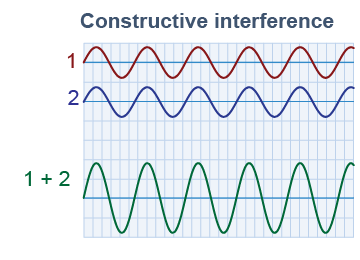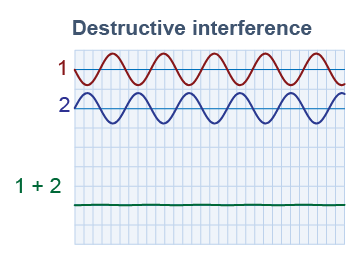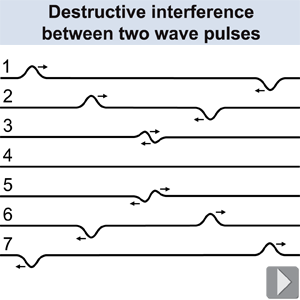|
 When more than one wave is present they can add to make a larger amplitude or a smaller amplitude wave. If the sum of two waves has a larger amplitude we say constructive interference has occurred. The diagram on the right shows constructive interference. When two waves interfere constructively the amplitude of the total wave is the sum of the amplitudes of the smaller waves. Both the wavelength and frequency stay the same.
When more than one wave is present they can add to make a larger amplitude or a smaller amplitude wave. If the sum of two waves has a larger amplitude we say constructive interference has occurred. The diagram on the right shows constructive interference. When two waves interfere constructively the amplitude of the total wave is the sum of the amplitudes of the smaller waves. Both the wavelength and frequency stay the same. 
 |
Sometimes, two large ocean waves can add up to make a truly gigantic rogue wave that may last only a short time but is taller than a ship. Rogue waves are believed to be the culprit behind many mysterious ship sinkings in the infamous Bermuda Triangle. 
|
 Two waves can also combine to make a smaller wave. Two waves that are identical in frequency and amplitude, but offset in time, can add up to make a wave of zero amplitude. A situation where one or more waves add up to make a smaller amplitude wave is called destructive interference. The diagram shows 100%, or total, destructive interference. In many cases, however, there is only partial destructive interference.
Two waves can also combine to make a smaller wave. Two waves that are identical in frequency and amplitude, but offset in time, can add up to make a wave of zero amplitude. A situation where one or more waves add up to make a smaller amplitude wave is called destructive interference. The diagram shows 100%, or total, destructive interference. In many cases, however, there is only partial destructive interference. 
|
 If two wave pulses—one with positive amplitude and the other with negative amplitude—start on opposite sides of a snaky spring, something truly interesting happens in the middle. When the pulses meet they cancel each other out. For a moment the string is flat and both pulses vanish! The next moment the pulses reappear after passing through each other, and then they race away from each other. This is another example of destructive interference, and it shows how the energy of a wave may still be present even if it is momentarily in a form that cannot be seen.
If two wave pulses—one with positive amplitude and the other with negative amplitude—start on opposite sides of a snaky spring, something truly interesting happens in the middle. When the pulses meet they cancel each other out. For a moment the string is flat and both pulses vanish! The next moment the pulses reappear after passing through each other, and then they race away from each other. This is another example of destructive interference, and it shows how the energy of a wave may still be present even if it is momentarily in a form that cannot be seen. 
|
Interference is a special case of the superposition principle. In most realistic situations many waves will be present. Some waves will interfere constructively at some places and times. Other waves will interfere destructively at different places and times. The interaction of echoes in a concert hall is a good example of many sound waves interfering with each other. Certain music halls are known for good sound. This means interference between echoes from the walls and sound heard directly from the stage does not change the balance of frequencies heard by the listener in an unpleasant way. 
|
Which of the following is not an example of wave interference and the superposition principle? - A car muffler produces sound to counteract noise from the engine.
- Ocean waves hit the shore and are absorbed by the beach.
- Noise-canceling headphones eliminate distracting noise by producing sound that is out of phase with the background noises.
- Light shown through two thin slits creates a diffraction pattern.
 |
The correct answer is b. Ocean waves hitting the shore is not an example of multiple waves interacting to produce a wave of different amplitude. 
|

